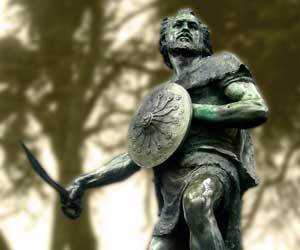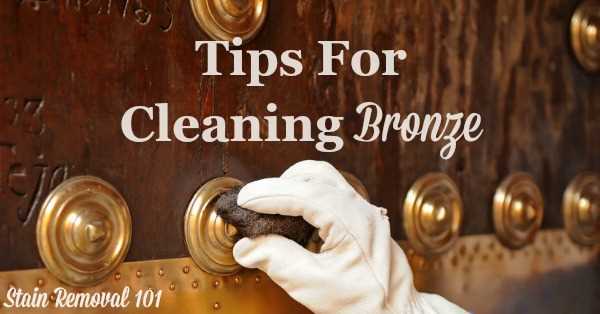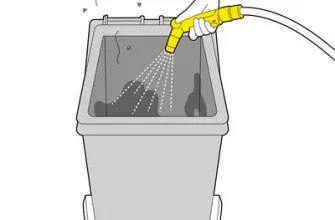
Bronze is a beautiful metal that has been used for centuries to create a variety of items, from sculptures and antique hardware to jewelry and coins. However, over time, bronze can become tarnished and lose its shine, which can affect its appearance. Fortunately, there are many simple and effective ways to clean and restore bronze to its former glory.
One of the easiest and most accessible methods for cleaning bronze is by using everyday household items. Toothpaste, for example, can be a surprisingly effective cleaning agent. Just apply a small amount of toothpaste onto a soft cloth and gently rub it onto the bronze surface in circular motions. Rinse off the toothpaste with warm water and buff the bronze dry with a clean cloth. This simple technique can help remove dirt, grime, and tarnish from the surface of the bronze.
If toothpaste doesn’t do the trick, another option is to create a homemade cleaning solution using lemon juice or vinegar. These acidic liquids can help dissolve any stubborn stains or tarnish on the bronze. To make the solution, mix equal parts lemon juice or vinegar with warm water in a bowl. Dip a soft cloth in the mixture and gently rub it onto the bronze surface. Rinse off the solution and dry the bronze thoroughly. This method can be used on most bronze items, but it is important to test it on a small, inconspicuous area first to ensure it doesn’t cause any damage.
For more stubborn stains or for bronze that has formed a green patina, a mixture of baking soda and lemon juice can be especially effective. Mix a small amount of lemon juice or vinegar with baking soda to create a paste. Apply the paste to the bronze, focusing on the areas that need the most attention. Let it sit for a few minutes, then scrub gently with a soft cloth. Rinse off the paste and dry the bronze. This method can help to remove tough stains and tarnish, leaving the bronze looking shiny and new.
When cleaning bronze, it is important to avoid using any harsh or abrasive cleaners, as these can cause damage to the surface. Gentle, mild cleaning solutions are always the best option. Additionally, it is important to never scrub or rub the bronze too hard, as this can also cause damage. Instead, use a gentle touch and let the cleaning solution do the work. If you are unsure about cleaning a valuable or delicate bronze item, it is always best to consult a professional for advice.
By following these tips and using the right cleaning solutions, you can keep your bronze items looking their best. Regular maintenance and cleaning will help prevent tarnish and keep the bronze looking shiny and beautiful. Whether you prefer using toothpaste, lemon juice, vinegar, or a variety of homemade solutions, there is always a way to bring your bronze pieces back to life and maintain their timeless elegance.
- Soap and Water
- Vinegar and Flour
- What you’ll need:
- Instructions:
- Lemon and Baking Soda
- Step 1: Mix the Cleaning Solution
- Step 2: Apply the Cleaning Solution
- Step 3: Rinse and Dry
- Additional Tips
- Ammonia and dish soap
- Materials Needed:
- Ketchup
- The Process:
- Tips:
- Video:
- How to clean copper, brass and bronze? | Hagerty
Soap and Water

One of the simplest and most effective ways to clean bronze objects is with soap and water. This method is especially useful for everyday cleaning and maintenance, as it is gentle enough to be used regularly without causing any damage to the bronze.
To clean bronze objects using soap and water, you will need the following:
- A mild dish soap
- A soft cloth or sponge
- Warm water
Here is a step-by-step guide on how to clean bronze using soap and water:
- Fill a basin or sink with warm water.
- Add a small amount of mild dish soap to the water and mix it well to create a soapy solution.
- Dip the cloth or sponge into the soapy solution and wring out any excess water.
- Gently wipe the bronze object with the damp cloth or sponge, making sure to clean all surfaces.
- If there are any stubborn stains or tarnishes, you can apply a bit of lemon juice or vinegar to the cloth and rub the affected areas.
- Rinse the object thoroughly with clean water to remove any soap residue.
- Dry the object with a soft cloth or let it air dry.
It is important to note that while soap and water can effectively remove dirt and grime from bronze, it may not be able to remove heavy tarnish or corrosion. In such cases, you may need to use alternative cleaning methods or seek professional help to restore the bronze object to its original shine.
Additionally, it is crucial to be cautious when cleaning antique or valuable bronze objects, as aggressive cleaning techniques or harsh materials can cause damage and reduce their value. Always test any cleaning solution on a small, inconspicuous area before applying it to the entire object to avoid any unwanted consequences.
In conclusion, soap and water is a simple and cost-effective method for cleaning bronze objects. Regular maintenance using this method can help preserve the appearance of bronze pieces and keep them looking their best for years to come.
Vinegar and Flour
One of the most effective and affordable ways to clean bronze objects is by using vinegar and flour. This simple method can help restore the shine to your bronze pieces without causing any damage to the surface or patina.
What you’ll need:

- White vinegar
- All-purpose flour
- A soft cloth or sponge
Instructions:
- Mix equal parts vinegar and flour to create a paste. You can start with 2-3 tablespoons of each.
- Apply the paste to the tarnished bronze object, making sure to cover the surface evenly.
- Let the paste sit on the bronze for about 10-15 minutes.
- Take a soft cloth or sponge and gently rub the paste onto the bronze, using circular motions.
- Rinse the object with warm water to remove any residue.
- If necessary, repeat the process to achieve the desired shine.
- Once clean, use a clean, dry cloth to blot the bronze and remove any excess moisture.
Note: While vinegar and flour are effective in cleaning bronze, keep in mind that this method may not be suitable for all types of bronze objects. Additionally, this cleaning solution may not be suitable for antique or valuable bronze pieces, as it can potentially alter the appearance or affect the value. It is always recommended to consult a professional before attempting to clean valuable or antique bronzes.
There are various other cleaning solutions that can be used for different types of bronze objects. These include using lemons, salt, dish soap, baking soda, tomato, or even toothpaste. However, it is important to follow the proper cleaning methods and avoid any solutions that may be too abrasive or damaging to the bronze surface.
In conclusion, vinegar and flour can be a cost-effective and gentle way to clean tarnished bronze objects. With proper care and attention, you can restore the shine and beauty of your bronze pieces without the risk of damaging them.
Lemon and Baking Soda
Lemon and baking soda are both effective natural cleaners that can be used to clean bronze objects. The acidic properties of lemon and the abrasive properties of baking soda make them a powerful combination for removing dirt, grime, and tarnish from bronze.
Materials You Will Need:
- Lemon
- Baking soda
- Water
- Soft cloth
Step 1: Mix the Cleaning Solution
- Squeeze the juice of a lemon into a bowl.
- Add a teaspoon of baking soda to the lemon juice.
- Add a few drops of water to create a paste-like consistency.
Step 2: Apply the Cleaning Solution
- Dip a soft cloth into the cleaning solution.
- Gently rub the cloth over the bronze object, applying light pressure.
- Focus on areas that are tarnished or dirty.
Step 3: Rinse and Dry
- Rinse the bronze object with water to remove any residue from the cleaning solution.
- Use a soft cloth to dry the object thoroughly.
Additional Tips
- For more stubborn stains or tarnish, you can add a small amount of baking soda directly onto the cloth and rub it onto the bronze object.
- Alternatively, you can use a toothpaste or ketchup as a substitute for the lemon and baking soda solution.
- Be careful when using harsh chemicals or abrasive materials to clean bronze, as they can damage the metal.
- If your bronze object has a patina that you want to preserve, avoid using lemon or other acidic cleaners, as they can remove or alter the patina.
- Regular maintenance with a soft, soapy cloth can help keep your bronze objects clean and shiny.
By following these tips and using a lemon and baking soda cleaning solution, you can effectively clean your bronze objects and restore their original appearance without causing any damage.
Ammonia and dish soap
One of the most common methods for cleaning bronze objects is using a combination of ammonia and dish soap. This method is effective for removing dirt, grime, and tarnish from various bronze items including sculptures, jewelry, and antique pieces. However, it’s important to note that ammonia can be damaging to certain types of bronze, so caution should be exercised when using this method.
Materials Needed:
- Ammonia (household cleaner)
- Dish soap (mild)
- Warm water
- Soft cloth or sponge
1. In a basin or sink, mix a solution of warm water, a few drops of dish soap, and a small amount of ammonia. Be cautious not to add too much ammonia, as it can be damaging to the bronze.
2. Gently place the bronze object into the solution, ensuring that it is completely submerged.
3. Allow the bronze object to soak in the solution for about 10-15 minutes. This will help to loosen any dirt or grime from the surface.
4. After soaking, use a soft cloth or sponge to gently scrub the bronze object. Be careful not to be too rough, as this can cause scratches or other damage to the surface.
5. Once the object has been cleaned, rinse it thoroughly with warm water to remove any residue from the cleaning solution.
6. Finally, dry the bronze object with a soft cloth, ensuring that it is completely dry before storing or displaying it.
It’s important to note that this method may not be suitable for all bronze objects. Some bronzes may have a protective coating that can be damaged by the ammonia and dish soap solution. If you are unsure, it’s always best to consult a professional or do a spot test on a small, inconspicuous area of the object before cleaning the entire surface.
In addition to the ammonia and dish soap method, there are several other ways to clean bronze objects. Some people prefer using natural cleaning solutions, such as vinegar or lemon juice, to avoid the use of harsh chemicals. Others may opt for commercial bronze cleaners, which can be more costly but may provide more gentle and effective results. Ultimately, the proper cleaning method will depend on the specific object and its condition.
Remember, proper cleaning and maintenance of bronze objects can help to preserve their shine and prevent corrosion or other damage. Using gentle cleaning methods and avoiding abrasive materials or harsh chemicals will ensure that your bronzes look their best for years to come.
Ketchup
One of the most surprising things that can clean bronze effectively is ketchup. Yes, you read it right! Ketchup, that popular condiment made from tomatoes, can actually help remove tarnish and bring back the shine to your bronze objects.
To clean bronze with ketchup, you’ll need a few basic things: ketchup, warm water, a soft cloth or sponge, and potentially some mild soap.
The Process:
- Start by applying a layer of ketchup on the bronze surface that needs to be cleaned. Make sure the entire area is covered evenly.
- Let the ketchup sit on the bronze for about 5 to 10 minutes. This will allow the acid in the tomatoes to work on the tarnish.
- After the waiting time, use a soft cloth or sponge to gently rub the bronze surface. You’ll start to see the tarnish being removed as you scrub.
- If the tarnish is stubborn and doesn’t come off easily, you can add a little bit of warm water and gentle soap to your cloth or sponge and continue rubbing.
- Once the surface is cleaned, rinse it with warm water to remove any residue.
- Finally, use a dry cloth to carefully dry the surface, ensuring that no moisture remains.
It is important to note that while ketchup can effectively clean bronze, it may not be suitable for all bronze objects. Some experts prefer using other cleaning solutions to avoid damaging the patina or surface of antique or delicate bronze pieces. Also, this method may work slightly better on bronze alloys compared to copper.
If you are unsure about using ketchup or want to explore other cleaning methods, there are several alternative ways to clean bronze, such as using baking soda, vinegar, flour paste, lemon juice, or even toothpaste. Each method has its own set of instructions and tips, so you can choose the one that suits your needs and preferences the most.
Proper maintenance and regular cleaning of bronze objects are essential to prevent corrosion and keep them looking shiny. By using the right solutions and following the correct cleaning techniques, you can ensure that your bronze items retain their beauty for years to come.
Tips:
- Always test any cleaning solution on a small, inconspicuous area of the bronze object first to avoid any unwanted consequences.
- When cleaning bronze, avoid using abrasive materials or harsh chemicals that can damage the surface.
- For sculptures or other intricate bronze objects, you may want to use a soft toothbrush to reach the crevices.
- Do not let the ketchup or any other cleaning solution sit on the bronze for too long to avoid any potential damage.
- Regularly dust and wipe your bronze objects to maintain their shine and prevent the build-up of dirt or grime.
| Method | Ingredients | Advantages |
|---|---|---|
| Ketchup | – Ketchup – Warm water – Mild soap (optional) |
– Easy to use – Does not require any special materials – Can remove tarnish effectively |
| Baking Soda | – Baking soda – Water |
– Gentle abrasive – Removes tarnish and stains |
| Vinegar | – Vinegar – Salt – Flour (optional) |
– Acidic properties remove tarnish – Flour paste can make cleaning easier |
| Toothpaste | – Toothpaste – Water |
– Mild abrasive – Convenient to use |








